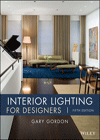In a New York Office Building, Loisos + Ubbelohde’s Fiber-Optic Sculpture Glows with the Light of the Sun
The solar-powered 'Light Fall' illuminates the interior stairwell of a company’s East Coast headquarters

Architects & Firms
Buried deep inside a mammoth office building that occupies an entire city block in Manhattan’s Chelsea neighborhood, a delicate column of light extends 15 stories, from the roof to the ground level, illuminating a dim, windowless stairwell. The shaft’s striking glow is not generated by electricity, however, but sunlight.
Light Fall, as this light sculpture is known, concentrates and directs daylight through a roof-mounted “light cannon,” or solar collector, and fiber optics. The latter’s glass strands (more than 5,000 miles of them, bundled and sheathed in translucent sleeves) are strung between steel rings, each 15 feet apart, and supported in the stairwell by four steel cables in tension. When the sun is shining, this “light dagger” transmits daylight down its 208-foot length, with the ends of the fibers producing bright, dotlike points of light.

1

2
Sunlight, rather than electricity, illuminates Light Fall, a 15-story fiber-optic sculpture installed within a stairwell (1). A rooftop light cannon (3) collects sunlight, directing it to a light box (2), which channels the daylight through the 208-foot-long “dagger.” Another set of optics creates a real-time image of the sun on the ceiling. Photos © George Loisos (1 & 2), Nicholas Venezia (3), click to enlarge.

3
The permanent installation was designed by Loisos + Ubbelohde, a San Francisco Bay Area architecture, daylighting, and energy-efficiency consultant. The firm has done a handful of light sculptures that collect and redirect sunlight, including one in a lab at Caltech in Pasadena (record, November 2012), but none are on the scale of Light Fall, which is part of a larger renovation project, overseen by architect HLW, to transform the 2.9 million-square-foot building into the East Coast headquarters of a global U.S.-based company.
Built in 1932 as a warehouse, and for industrial uses, the existing structure included elevators to accommodate trucks. It is one of these oversize shafts, converted into a stairwell for office-occupancy egress requirements, that houses Light Fall. The idea behind the installation is to encourage tenants to use the stair, not only in an emergency but to routinely travel between floors. “We wanted to draw people in and make a pedestrian space that stands out,” says Lee Devore, an HLW principal.
The stair’s ambient lighting, by consultant Lumen Architecture, was conceived to keep the focus on the sculpture and is largely indirect, with LEDs shielded by the stair’s folded metal handrail. The approach creates a subtle backdrop for Light Fall while providing sufficient light levels on cloudy days and during evening hours.
The “light cannon” that creates the daylight effect is actually a reflecting telescope with two mirrors—one convex and one concave—that rotates vertically and horizontally to track the path of the sun. An automated system relying on mathematics and optical tracking directs the movement of the 18-foot-tall, 36,000-pound instrument. These controls also take information into account from a nearby weather station: during overcast days and severe storms, the system locks the telescope until conditions improve. The safety feature reduces wear and tear on the telescope’s moving components, explains George Loisos, Loisos + Ubbelohde principal. A series of mirrors and lenses redirects sunlight to a “light box” suspended from a truss at the top of the stair and to the fiber-optic dagger. A second set of optics produces a real-time image of the sun on the stair’s ceiling, even revealing sunspots.
It took almost a decade to finish Light Fall, due to technical and logistical setbacks, including mirrors fabricated from polycarbonate instead of the specified glass, a sealant melted by the intensity of the sun, dust that migrated into the telescope from nearby demolition, replacement of a contractor, and finally Covid. “It has been a learning process,” says Loisos—one that now offers building tenants a rare manifestation of the sun, indoors.
Click graphic to enlarge

Click graphic to enlarge

Read more about lighting projects from the February 2023 Issue
Credits
Architect:
Loisos + Ubbelohde — George Loisos, designer; Eduardo Pintos, Susanna Douglas, Susan Ubbelohde, core team; Alan DeMarche, Steven Eichbaum, project team
Architect of Record:
HLW
Engineer:
Mar Structural Design
General Contractor:
Talisen
Consultants:
Starman Systems (telescope controls); Optical Mechanics (optical design/ fabrication/assembly); Displays and Optical Technologies (mirror fabrication); Lumen Architecture (lighting design)
Client:
JLL
Size:
10,500 square feet
Construction Cost:
$2 million
Completion Date:
October 2022
Sources
Cladding & Roofing:
Alucobond (light cannon)
Glazing:
Schott (Borofloat)






